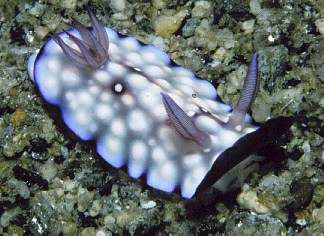
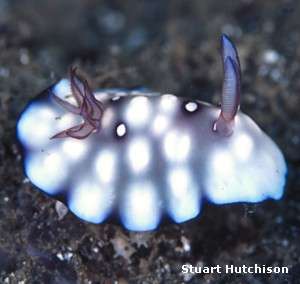
Chromodoris hintuanensis
Gosliner & Behrens, 1998
Order: NUDIBRANCHIA
Suborder: DORIDINA
Superfamily: EUDORIDOIDEA
Family: Chromodorididae
DISTRIBUTION
Philippines, Japan (Okinawa), Thailand (Andaman Sea), Indonesia, Papua New Guinea. Also Forum records from Solomon Ids and Sri Lanka.
PHOTO
UPPER: Luadi, Milne Bay, Papua New Guinea, March 27, 1998. 25 mm long. PHOTO M.J.Adams.
LOWER: Milne Bay, Papua New Guinea, approx 2.5 cm. PHOTO: Stuart Hutchison.
Quite similar in appearance to C. geometrica. Two major points of difference are the rhinophore & gill colour and the presence of a few small white rounded nodules on the mantle, each surrounded by a ring of deep magenta (or purple). The gills and rhinophores are a translucent reddish purple colour edged with a dark line of the same colour. Like C. geometrica the anterior mantle waves up and down rhythmically and its underside is a deep purplish colour.
Reference:
• Gosliner, T.M. & Behrens, D.W. (1998) Five new species of Chromodoris (Mollusca: Nudibranchia: Chromodorididae) from the tropical Indo-West Pacific. Proceedings of the California Academy of Sciences, 50(5): 139-165.
Rudman, W.B., 2000 (January 28) Chromodoris hintuanensis Gosliner & Behrens, 1998. [In] Sea Slug Forum. Australian Museum, Sydney. Available from http://www.seaslugforum.net/find/chrohint
Related messages
Re: Chromodoris hintuanesis from the Solomons
February 25, 2008
From: Barbara Hanchard
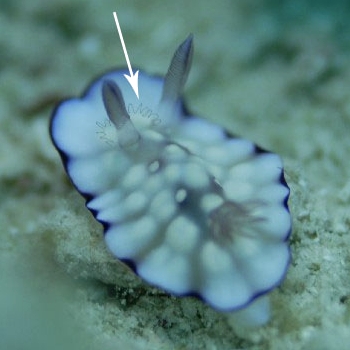
Concerning message #21298:
Bill,
While editing photos I spotted something which I think is unusual on another Chromodoris hintuanesis. I found this animal a week later on 16 Dec 2007 at a different group of islands (Floridas) from the one posted on 1 Feb (Russells).
It seems to have spiral filament going between the rhinophores. It looks like the wire filament in a light bulb or is it a pattern on the mantle? Do you know what it is?
Locality: Tulaghi, Florida Islands, 10 meters, Solomon Islands, Pacific Ocean, 16 December 2007, Sandy sloping reef. Length: 15mm. Photographer: N. Barbara Hanchard.
N. Barbara Hanchard
barbara.hanchard@ffa.int
Hanchard, N.B., 2008 (Feb 25) Re: Chromodoris hintuanesis from the Solomons. [Message in] Sea Slug Forum. Australian Museum, Sydney. Available from http://www.seaslugforum.net/find/21394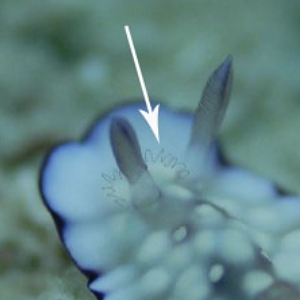
Dear Barbara,
The short answer is no. I am not sure if you still use slide film or if you ever take photos in a dish or aquarium, or handle the animals in the field?
Why I ask is that my first thought was a bit of cotton or nylon thread. Sometimes with slides a bit of stray material lands on the transparency and is 'captured' in scans or prints. However since it clearly goes behind one of the rhinophores, if it is a foreign object then it is on the animal not the film. Certainly it is possible for small hairs and threads to be caught on an animal which is in a dish in the lab waiting to be photographed. Otherwise I have no suggestions.
Best wishes,
Bill Rudman
Chromodoris hintuanesis from the Solomons
February 1, 2008
From: Barbara Hanchard
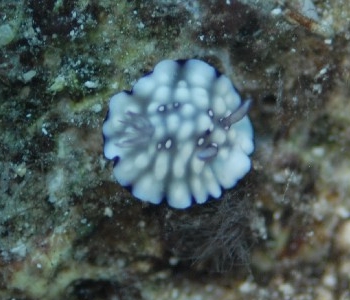
Hi Bill,
If I am in fact correct and this is Chromodoris hintuanesis, it will extend the distribution range further west of South east Asia and PNG than the forum recognises to date. I intially thought it might be a juvenile form of C. geometrica but then realised that both the rhinopores and gills are pink and not the green associated with C. geometrica. This animal was very small and hard to photograph so I apologise for the photo quality.
Locality: Wreck of the Ann Reef, 8 meters, Russell Islands, Solomon Islands, Pacific Ocean, 8 December 2007, Sandy sloping reef. Length: 15 mm. Photographer: N.Barbara Hanchard.
Regards
Barbara Hanchard
barbara.hanchard@ffa.int
Hanchard, N.B., 2008 (Feb 1) Chromodoris hintuanesis from the Solomons. [Message in] Sea Slug Forum. Australian Museum, Sydney. Available from http://www.seaslugforum.net/find/21298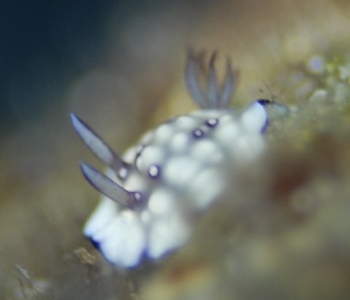
Dear Barbara,
Thanks for the record. Although I try and keep the species distribution information on the Fact Sheet up to date sometimes I fail, so when a message like yours specifically mentions geographic ranges I do a quick check through recent messages to see if I've missed something. In this case I should have included message #20838 which extends the geographic range to Sri Lanka, halfway across the Indian Ocean.
Best wishes,
Bill Rudman
Chromodoris hintuanensis from the Andaman Sea
November 28, 2007
From: Mike Hohman
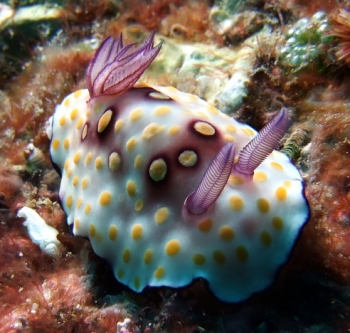
Can anyone please help me identify the species of this Chromodoris nudibranch? Photo taken Nov 8th at Elephant Head Rock dive site in the Similan Islands of the West Coast of Thailand in the Andaman Sea. Nudi was crawling across a large boulder at a depth of 12m.
Locality: Elephant Head Rock, 12m, Similan Islands, Thailand, Andaman Sea, 8 November 2007, Coral Reef with Boulders. Length: 3-4 cm. Photographer: Mike Hohman.
Mike Hohman
mikehohman@yahoo.com
Hohman, M., 2007 (Nov 28) Chromodoris hintuanensis from the Andaman Sea. [Message in] Sea Slug Forum. Australian Museum, Sydney. Available from http://www.seaslugforum.net/find/21117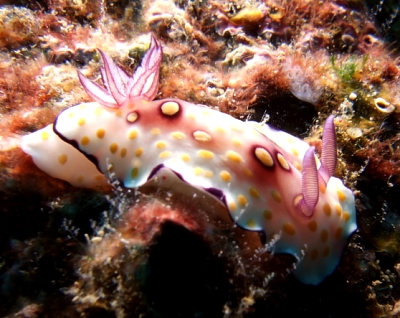
Dear Mike,
This is Chromodoris hintuanensis.
Best wishes,
Bill Rudman
Chromodoris hintuanensis from Sri Lanka
September 28, 2007
From: Anouk Houben
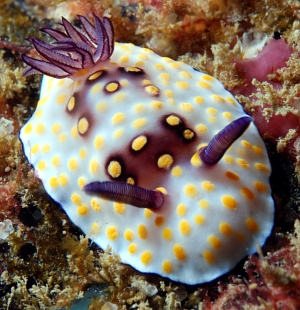
This Sri Lankan Chromodoris hintuanensis is very similar to the Thai yellow spotted one [message #9692 ].
Locality: Prinz Heinrich Patch, Weligama, 15 m, Sri Lanka, Indian Ocean, april 2007, Rock formations. Length: 5 cm. Photographer: Anouk Houben.
Kind regards,
Anouk
nashiman@lankacom.net
Houben, A., 2007 (Sep 28) Chromodoris hintuanensis from Sri Lanka. [Message in] Sea Slug Forum. Australian Museum, Sydney. Available from http://www.seaslugforum.net/find/20838Thanks Anouk,
This is a very interesting record. As far as I know C. hintuanensis has not been recorded this far west in the Indian Ocean. It also seems that the fauna of the coast of Thailand and Burma has an interesting link to the western Indian Ocean as well as a link to Indonesia and the Philippines The yellow spots in your animal and the yellow spots in animals on the Forum from Thailand and Burma, further support the connection.
Best wishes,
Bill Rudman
Re: 3 Horned Chromodoris hintuanensis
August 31, 2007
From: Jeffrey de Guzman
Concerning message #20396:
Dear Bill
My friend told me she took a picture of a 3-horned Chromodoris hintuanensis about the same time last year. Carlos Munda and I were diving together. I didn't know he also submitted his photos to you.
Jeffrey de Guzman
de Guzman, J., 2007 (Aug 31) Re: 3 Horned Chromodoris hintuanensis. [Message in] Sea Slug Forum. Australian Museum, Sydney. Available from http://www.seaslugforum.net/find/20598Thanks Jeffrey,
It's nice to know 3-horned chromodorids aren't taking over
Best wishes,
Bill Rudman
3 Horned Chromodoris hintuanensis
August 24, 2007
From: Jeffrey de Guzman
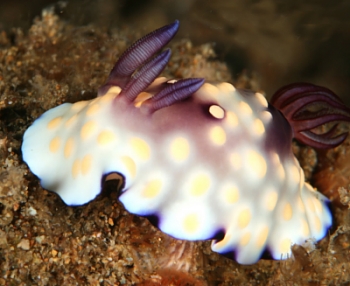
I found a 3 horned Chromodoris hintuanensis in Anilao Batangas Philippines.
Locality: Anilao Batangas, 60 Feet, Philippines, Philippine, 01 July 2007, Rocky sandy incline. Length: 2 inches. Photographer: Jeffrey de Guzman.
Jeffrey de Guzman
jeffdeguzman@gmail.com
de Guzman, Jeffrey, 2007 (Aug 24) 3 Horned Chromodoris hintuanensis. [Message in] Sea Slug Forum. Australian Museum, Sydney. Available from http://www.seaslugforum.net/find/20396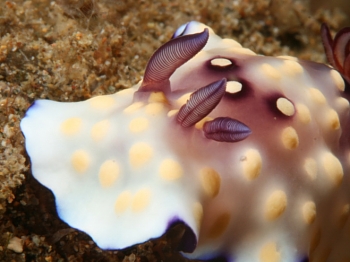
Dear Jeff,
This is the second report of C. hintuanensis with three rhinophores, found at about the same time in the Philippines [message #20212]. I hope it's just a coincidence and not a sign of something nasty in the water.
Best wishes,
Bill Rudman
Mutant Chromodoris hintuanensis?
July 19, 2007
From: Carlos R. Munda
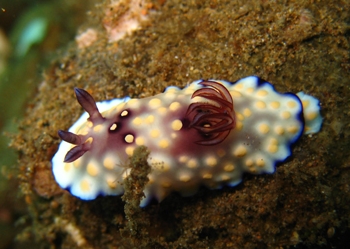
I have heard that some nudibranchs develop a third feeler during mating season. Is this true? If not, what could be the explanation for this mutation in Chromodoris hintuanensis?
Locality: Mainit Bubbles Beach, 10 meters, Philippines, Pacific Ocean, June 30, 2007, Sandy beach. Length: 1 inch (approximately). Photographer: Carlos R. Munda, Jr..
Carlos R. Munda, Jr.
c_munda@yahoo.com
Munda, C., 2007 (Jul 19) Mutant Chromodoris hintuanensis?. [Message in] Sea Slug Forum. Australian Museum, Sydney. Available from http://www.seaslugforum.net/find/20212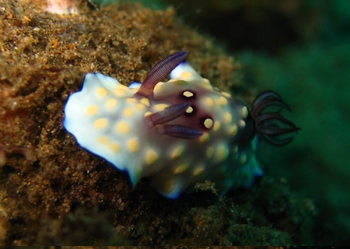
Dear Carlos,
I have never heard of this and I am sure if it were true we would have many more photos of nudibranchs with third rhinophores. I suspect this is just a developmental 'mistake'. The process of an egg developing into an almost identical match to it parents is amazing, but there are often small errors in the process. An extra rhinophore like this probably doesn't interfere with a normal life so even though it looks strange to us I guess it doesn't really matter to the animal. This type of error may be a mistake in the genetic makeup of the animal but is more likely to be a local error occurring during the growth of the embryo. It is unlikely that this animal would give rise to a family of offspring with 3 rhinophores. Have a look at the abnormalities page for more anomalies.
Best wishes,
Bill Rudman
Chromodoris hintuanensis from the Philippines
July 3, 2007
From: Carlos R. Munda
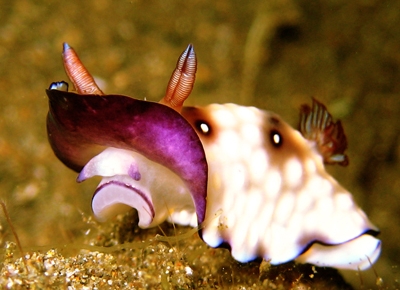
I would appreciate help in identifying what this is.
Locality: anilao, batangas, 10 meters, philippines, pacific, 18 February 2007, muddy. Length: 2-3 inches. Photographer: carlos r. munda, jr..
Carlos Munda
c_munda@yahoo.com
Munda, C., 2007 (Jul 3) Chromodoris hintuanensis from the Philippines. [Message in] Sea Slug Forum. Australian Museum, Sydney. Available from http://www.seaslugforum.net/find/19501Dear Carlos,
This is Chromodoris hintuanensis. The photo is quite interesting because it shows the way this species flaps the front of the mantle up and down and how the underside is deep purple. Chromodoris geometrica and a number of other similar species also have this purple patch.
On a separate matter. This email has taken me some months to answer. One of the reasons I can't answer all the messages I get quickly is that I have to spend a lot of time 'editing' them. This one had two quite different species in it. Every time I have to split a message into two or three it means I have to waste time I could be spending on answering questions. Also can you please use upper case letters at the start of place names and include 'island' etc when necessary not: anilao, batangas. And please no names in full upper case such CARLOS. This is not a complaint aimed specially at you - lots of other participants are not following the simple rules I ask for [see Instructions on sending messages]. Your message is just a good example of the problems I have. If everyone followed these requests I would have more time to do what I can do best - answer messages.
Best wishes,
Bill Rudman
Chromodoris hintuanensis from Bali
November 8, 2005
From: Marli Wakeling

Hi Bill,
More stuff from Tulamben: Chromodoris hintuanensis, this time.
Locality: Tulamben, Bali, Indonesia. Depth: 20 feet. Length: 20 mm. 24 July 2005. Sand and rubble slope. Photographer: Marli Wakeling
Cheers,
Marli
scubamarli@gmail.com
Wakeling, M., 2005 (Nov 8) Chromodoris hintuanensis from Bali. [Message in] Sea Slug Forum. Australian Museum, Sydney. Available from http://www.seaslugforum.net/find/15191Thanks Marli,
Bill Rudman
Chromodoris hintuanensis from Burma
January 13, 2004
From: Golf Napas
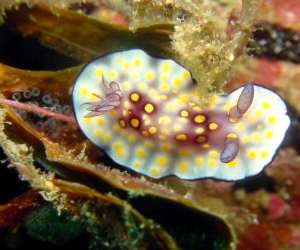
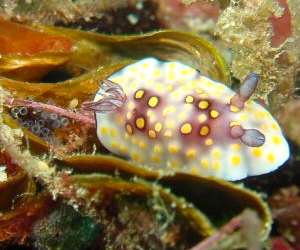
Both picture was taken from OK Rock, Burma-Andaman Sea at December 4, 2003 on sandy bottom. It's about 20mm long at 60ft depth. Isn't it a Chromodoris hintuanensis? The second picture shown a purple tubes behind, isn't it her eggs?
Napas, Golf
napaschon@pacific.co.th
Napas, G., 2004 (Jan 13) Chromodoris hintuanensis from Burma. [Message in] Sea Slug Forum. Australian Museum, Sydney. Available from http://www.seaslugforum.net/find/11793Dear Golf,
Thanks for these photos. This species is variable in colour so it is godd to get more phoptos of this yellow spotted form which seems to be more common in the Andaman Sea than further south in Indonesia. Concerning the possible eggs. Have a look at Michael Miller's message for a photo of this species laying its eggs. It;s always very difficult to say and egg belongs to an animal just because its nearby. Eggs last for many days and few animals, apart from fish, stay around to look after their eggs once they have produced them. If the purple things are mollusc eggs they are most likely to be from a snail of some kind. From what I can see they seem to all have hatched. In your photo they seem to be a series of little rings, but what I think they were is a series of dome shaped capsules which have now opened at the top - the opening appearing a bit darker than the rest of the capsule in your photo.
Best wishes
Bill Rudman
Re: Chromodoris hintuanensis? from Thailand
May 10, 2003
From: Harro Quitzau
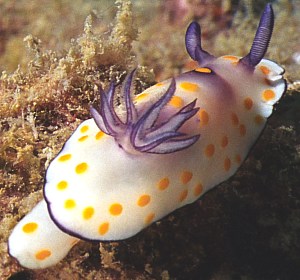
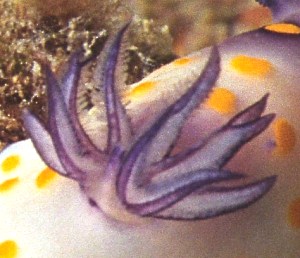
Hello Bill,
Thank you for your answer. Here are a other image of this nice nudi. I think, you can see more details.
Best wishes,
Harro Quitzau
Harro@Quitzau.info
Quitzau, H., 2003 (May 10) Re: Chromodoris hintuanensis? from Thailand. [Message in] Sea Slug Forum. Australian Museum, Sydney. Available from http://www.seaslugforum.net/find/9866Thanks Harro,
Yes I think we can say thhat the gills certainly are quadrangular in cross-section. I would certainly like to see this detail in some more typically coloured specimens of the species as it could be a useful character.
Best wishes,
Bill Rudman
Chromodoris hintuanensis? from Thailand
May 1, 2003
From: Harro Quitzau
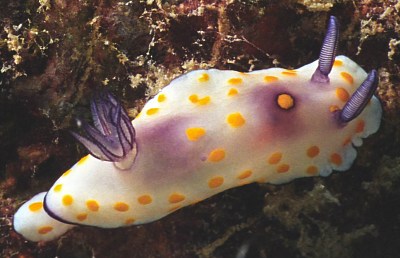
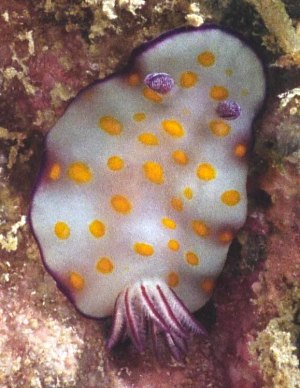
Hello Bill,
Please can you help me? I'm not sure if both these are Chromodoris hintuanensis. Or no one? Found in Thailand
Upper: Dive Site: Phuket Kamala - Tin Lizzy - at March 08, 2002 (Deep 9,5m)
Lower: Dive Site: Phuket Kamala - House reef - at March 09, 2002 (Deep 4m)
Can you please verify?
Thanks,
Harro Quitzau
Harro@Quitzau.info
Quitzau, H., 2003 (May 1) Chromodoris hintuanensis? from Thailand. [Message in] Sea Slug Forum. Australian Museum, Sydney. Available from http://www.seaslugforum.net/find/9692Dear Harro,
Thanks for the photos. Every set of photos I have been sent of these yellow spotted animals is helping to sort them out. First, the lower photo is a juvenile Risbecia pulchella. See my recent message discussing this species.
The upper photo certainly fits on of the 'colour forms' of Chromodoris hintuanensis. It is very similar to Mary Jane Adam's photos from Burma, but your animal has only one yellow spot ringed with purple. I am more and more convined that the Andaman Sea region seems to be a place where yellow-spotted species are evolving - or have evolved, much like the blue chromodorids of the Mediterranean or the red-spotted chromodorids of southeastern Australia.
One interesting feature I can see in your photo is that the gills are essentially quadrangular in cross section. I can clearly see the outside face of a number of gills with two purple lines outlining their edges. The inside fae of the gills is less easy to see but I can see at least one pair of purple lines, quite close together but at least a double line. If not quadrangular in cross-setion they are more than triangular. Looking through the other photos on the Forum, it is not that easy to see this feature but a can see double outer lines in both major colour forms - another feature liking them together.
Best wishes,
Bill Rudman
Chromodoris hintuanensis with egg mass
May 1, 2003
From: Michael D. Miller
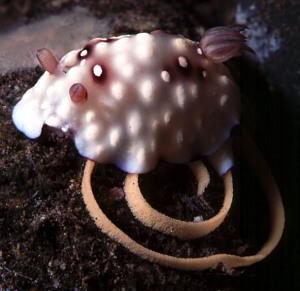
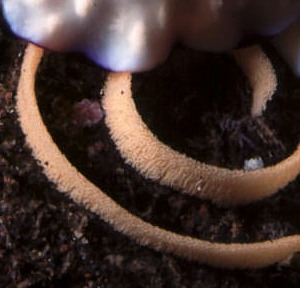
Dear Bill,
Here is a pic of Chromodoris hintuanensis with egg mass for your readers.
Location: Tulamben, Bali, Indonesia
Depth: 25 ft.
Date: Sept. 2002
Photographer: Michael D. Miller
Cheers,
Mike Miller
mdmiller@cts.com
Miller, M.D., 2003 (May 1) Chromodoris hintuanensis with egg mass. [Message in] Sea Slug Forum. Australian Museum, Sydney. Available from http://www.seaslugforum.net/find/9779Dear Mike,
Another interesting observation. This egg ribbon is very similar in shape and colour to that of the very similarly coloured Chromodoris annulata. See messages from Mary Jane Adams and Orhan Aytur. It is similarly coloured and quite narrow, suggesting that like C. annulata it does not have to be unfolded when laid [see message].
I am not suggesting that they are forms of one species, but I wouldn't be surprised if they are closely related.
Best wishes,
Bill Rudman
Chromodoris hintuanensis from Bali
April 1, 2003
From: Danny Van Belle
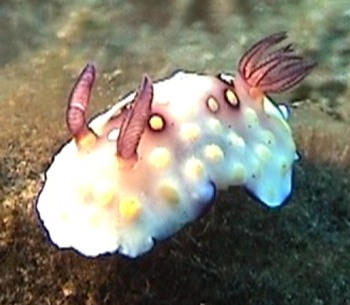
Dear Bill,
Another one from Tulamben, Bali, Indonesia. This Chromodoris hintuanensis may be of interest. It looks more white when compared to the ones in Thailand.
Cheers,
Danny
dannyvb@hotmail.com
Van Belle, D., 2003 (Apr 1) Chromodoris hintuanensis from Bali. [Message in] Sea Slug Forum. Australian Museum, Sydney. Available from http://www.seaslugforum.net/find/9527Thanks Danny,
It's nice to get a 'Thai'-looking specimen from Bali. It certainly helps to have a comprehensive collection of colour variation. I'm pretty sure these are all forms of one species.
Best wishes,
Bill Rudman
Ringless Chromodoris annulata?
March 28, 2003
From: Mary Jane Adams
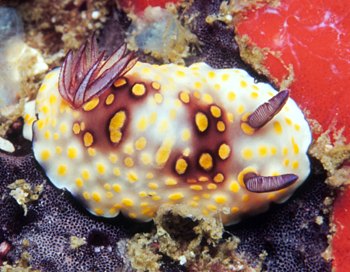
Hi Bill,
I'm not sure what this is. It has some resemblance to other slugs from Thailand that you have called Chromodoris hintuanensis The gills, rhinophores and yellow spots look a lot like Chromodoris annulata. However, the two splotches of purple on the notum have me confounded. This slug was only 15mm long, so it could be a juvenile.
I photographed it at about 15 meters on an un-named divesite in the Mergui Archipelago, Andaman Sea, Myanmar. Feb. 17, 2003.
Best regards,
Mary Jane
divepng@yahoo.com
Adams, M.J., 2003 (Mar 28) Ringless Chromodoris annulata?. [Message in] Sea Slug Forum. Australian Museum, Sydney. Available from http://www.seaslugforum.net/find/9464Thanks Mary Jane,
I may be wrong but I am pretty sure this is a colour form of Chromodoris hintuanensis. Looking through the photos we now have on the Forum there seems to be quite a series showing a continuum in the colour pattern. Of great interest is the purple sponge your animal is on. It is probably the same as C. geometrica feeds on.
Best wishes,
Bill Rudman
Yellow-spotted Chromodoris hintuanensis
February 13, 2003
From: Danny Van Belle
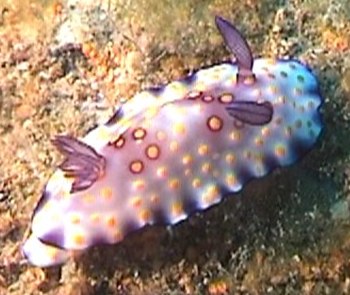
Hi Bill,
Is it possible this one is Chromodoris hintuanensis?
Divesite: Boonsung wreck, Tap Lamu Ids, west coast Thailand.
Depth: 18m
Date: 03 March 2001
Danny Van Belle
dannyvb@hotmail.com
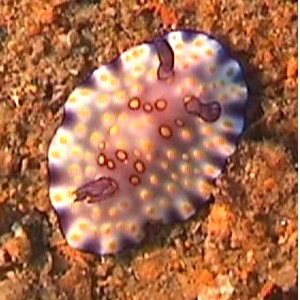
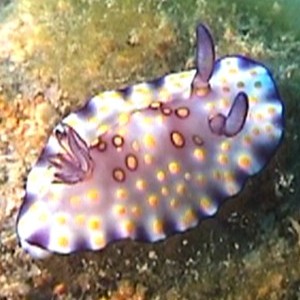
Dear Danny,
I am pretty sure this is Chromodoris hintuanensis, but the yellow spots are unusual. In fact the only other specimen I know of with yellow spots is also from Thailand. It makes me wonder whether it is perhaps mimicking other yellow-spotted species n the Andaman Sea such as Chromodoris annulata. Photos such as yours are very valuable in helping us to get a broad picture of colour variation across the geographic range of individual species.
Best wishes,
Bill Rudman
Chromodoris hintuanensis from Papua New Guinea
May 20, 2002
From: Andy H

Anyone help me ID this nudi that I can't find in my reference books? Found at night on an open sandy bottom, 35ft, Lion island (Bootless bay), PNG, March 2002. Approx 3cm.
Thanks,
Andy
andy.aj@virgin.net
Andy H, 2002 (May 20) Chromodoris hintuanensis from Papua New Guinea. [Message in] Sea Slug Forum. Australian Museum, Sydney. Available from http://www.seaslugforum.net/find/6983Dear Andy,
This is a fairly recently described species, Chromodoris hintuanensis, so it hasn't made many of the popular books yet.
best wishes,
Bill Rudman
Chromodoris hintuanensis from Bali
February 17, 2002
From: Stuart Hutchison
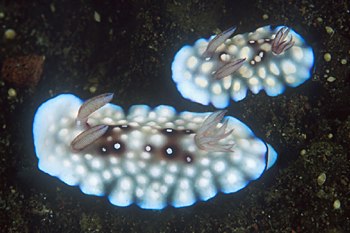
Bill,
These come from various shallow water sites around Bali, Indonesia on Oct 01, 2001. The juvenile [lower right] was only about 10mm long and the largest adults were 30mm. No apparent specific food source, but always found on algae covered rocks or volcanic sand.
Stuart
stuart@stuarthutchison.com.au
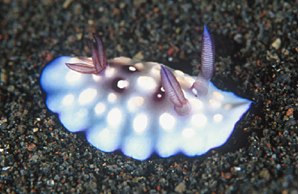
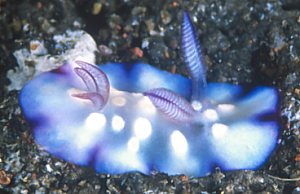
Thanks Stuart,
It's nice to get a good selection of photos of this relatively unknown species so we have a better idea of colour variation.
Bill Rudman
Chromodoris hintuanensis from Bali (2)
February 17, 2002
From: Stuart Hutchison
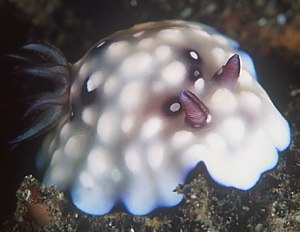
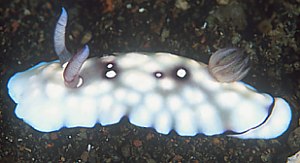
Bill,
Here are some more shots of Chromodoris hintuanensis to go with the others. Repeatedly found in shallows on algae covered rocks and volcanic sand in Bali, Indonesia. Up to 40mm in length.
Stuart
stuart@stuarthutchison.com.au
Hutchison, S., 2002 (Feb 17) Chromodoris hintuanensis from Bali (2). [Message in] Sea Slug Forum. Australian Museum, Sydney. Available from http://www.seaslugforum.net/find/6256Thanks Stuart,
I suspect their food sponge must be close by. Perhaps it is one of those sponges that forms a thin layer over the substrate and is partially covered in sand and other debris. or perhaps it is a sponge that incorporates sand grains in its tissue and so looks invisible. It would certainly be useful, next time you see a crowd of them to gently lift a few up and see if they have their mouthparts everted.
Cheers,
Bill Rudman
Chromodoris hintuanensis from the Philippines
January 15, 2002
From: Erwin Köhler

Dear Bill,
Here is Chromodoris hintuanensis from the Philippines by Georg Heinze,(email Georg.Heinze@t-online.de)
data: size ~2 cm, depth 18m, May 2001, Cabilao Island, divesite "Lighthouse Point"
Erwin
Erwin@medslugs.de
Köhler,E., 2002 (Jan 15) Chromodoris hintuanensis from the Philippines. [Message in] Sea Slug Forum. Australian Museum, Sydney. Available from http://www.seaslugforum.net/find/5873Thanks Erwin,
Bill Rudman.
Chromodoris hintuanensis from the Line Islands
October 25, 2001
From: Cory Pittman
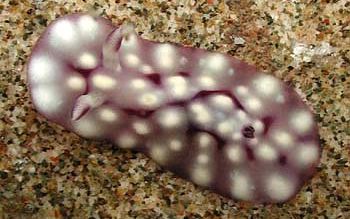
Dear Bill,
This was the only Chromodorid I found during my recent trip [September 2001] to Christmas Island, Line Islands. It was under a piece of coral rubble near the margin of a sand channel at about 12 m. It flapped its mantle front occasionally and vibrated its branchia. It was 12 mm in length. Due to the violet edging on the branchia and rhinophores, I suspect that it's a young Chromodoris hintuanensis that's "in transition" from the juvenile to the adult pattern rather than a juvenile C. geometrica.
Best wishes,
Cory
norm@maui.net
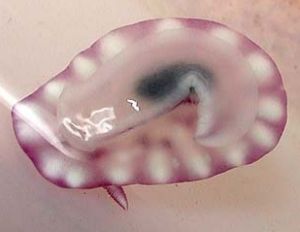
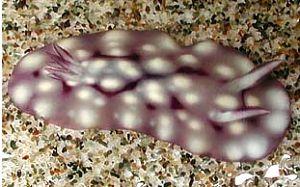
Dear Cory,
Certainly the purple edged gills and the rhinophores are typical of Chromodoris hintuanensis rather than C. geometrica. Glad to hear it 'vibrates' its gills - some of the photos, such as Stuart Hutchisons at the top of the page, suggest that the gills are in motion.
Best wishes,
Bill Rudman
Chromodoris hintuanensis from NE Sulawesi
August 6, 2001
From: Jim Anderson
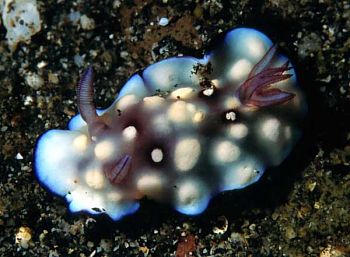
Dear Dr. Rudman,
Another one I can't identify from Lembeh Strait. NE Sulawesi, Indonesia. At 18 metres on 27 June 2001. 22 mm long approx.
Regards,
Jim A
jander4454@aol.com
Anderson, J., 2001 (Aug 6) Chromodoris hintuanensis from NE Sulawesi. [Message in] Sea Slug Forum. Australian Museum, Sydney. Available from http://www.seaslugforum.net/find/5001Dear Jim,
This is Chromodoris hintuanensis.
Best wishes,
Bill Rudman.
Juvenile Chromodoris hintuanensis
January 27, 2001
From: Michael D. Miller
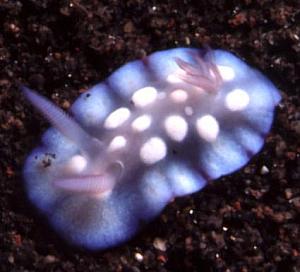
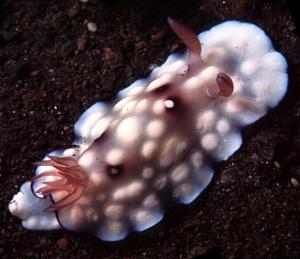
Dear Bill
In reviewing the section on Chromodoris hintuanensis, I came across a
communication from Lindsay Warren [19 April 2000] regarding the identity of a small
Chromodoris which Lindsay thought was probably a juvenile form of Chromodoris hintuanensis. A number of these
small chromodorids were found in concert with a sizable population of adult Chromodoris hintuanensis on a recent trip to Tulamben, Bali, Indonesia.
[UPPER PHOTO is juvenile, LOWER PHOTO an adult]. No Chromodoris roboi were observed.
Location: Tulamben, Bali, Indonesia
Depth: 20 ft. Date: Oct. 2000
Photographer: Michael Miller
Cheers,
Mike
mdmiller@cts.com
Miller, M.D., 2001 (Jan 27) Juvenile Chromodoris hintuanensis. [Message in] Sea Slug Forum. Australian Museum, Sydney. Available from http://www.seaslugforum.net/find/3625Thanks Mike,
Looks like you've solved on of life's little mysteries.
Best wishes,
Bill
Re: Striped Chromodoris roboi?
April 19, 2000
From: Lindsay Warren
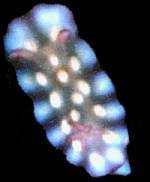
Dear Bill
I was just looking at the new shots of Chromodoris hintuanensis posted on 18/4/2000 and it reminded me of the little chap I sent to you in 1998. [copy of photo on right] At that time you thought it might be a juvenile C. roboi but on looking at it again and C. hintuanensis, it seems to be closer to it than C. roboi.
I haven't come across it again but am still hopeful.
All the best
Lindsay Warren
100014.2112@compuserve.com
Warren, L., 2000 (Apr 19) Re: Striped Chromodoris roboi?. [Message in] Sea Slug Forum. Australian Museum, Sydney. Available from http://www.seaslugforum.net/find/2292Dear Lindsay,
Just checked it myself and I think you are probably right. It would be nice to get some intermediate size animals.
Best wishes,
Bill Rudman.
Chromodoris hintuanensis from Thailand
April 17, 2000
From: N. Sittithaweepat
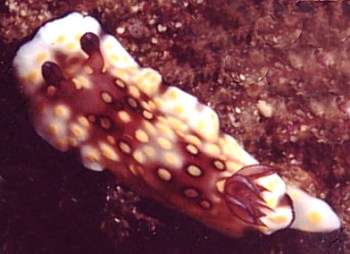
Dear Bill
I can't identify this nudibranch. I found it at Similan Island and photo by Dr. Thon Thamrongnawasawat. I don't record date and depth.
Thank you
Narongpon Sittithaweepat
chromodorid@thaimail.com
Sittithaweepat, N., 2000 (Apr 17) Chromodoris hintuanensis from Thailand. [Message in] Sea Slug Forum. Australian Museum, Sydney. Available from http://www.seaslugforum.net/find/2249Dear Narongpon,
I am pretty sure this is a recently named species, Chromodoris hintuanensis, which is known at present from the Papua New Guinea, Indonesia, Philippines and Thailand. Your animal is interesting because it has distinct yellow spots which are not present in other photos I have seen. In other specimens these spots are cream coloured. If you have any other photos of this or similarly coloured animals I would like to see them so we can have a better idea of the colour range of this species.
Best wishes,
Bill Rudman.
Distribution of Chromodoris hintuanensis
January 31, 2000
From: Bill Rudman.
In my comments on Stuart Hutchison's recent photo of Chromodoris hintuanensis I suggested that it was the first record south of the Philippines. That was incorrect. Chromodoris hintuanensis was Nudibranch of Week 113 on Mike Miller's great website and he has records from Bali, Indonesia; Papua New Guinea; Okinawa, Ryukyu Islands; the Andaman Sea, Thailand; and at several locations in the Batangas Province of the Philippines.
I clearly shouldn't rely on my faulty memory.
Bill Rudman.
Re: Chromodoris hintuanensis
January 30, 2000
From: Mary Jane Adams

Hi Bill,
I have photographed C. hintuanesis at a couple of dive sites in Milne Bay, Papua New Guinea. This picture was taken at Luadi on March 27, 1998. It was about 25 mm long. I found it on a silty sand slope at about 8 meters. I love the way it lifts its mantle when it crawls.
Best regards,
Mary Jane
mjadams@earthlink.net
Adams, M.J., 2000 (Jan 30) Re: Chromodoris hintuanensis. [Message in] Sea Slug Forum. Australian Museum, Sydney. Available from http://www.seaslugforum.net/find/1811Dear Mary Jane,
Thanks for this great shot showing how they flap the front of their mantle, and the purple colour underneath.
Bill Rudman.
Chromodoris hintuanensis from Papua New Guinea
January 29, 2000
From: Bill Rudman

Here is a photo of Chromodoris hintuanensis which Stuart Hutchison just sent in as a colour form of Chromodoris geometrica. It is from Milne Bay, Papua New Guinea) and was a about an inch (2cm) long.
This is the first record of it south of the Philippines.
Bill Rudman.
